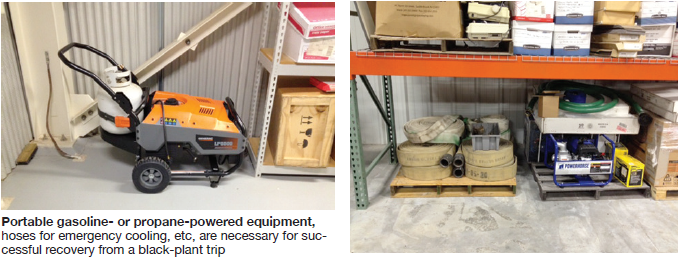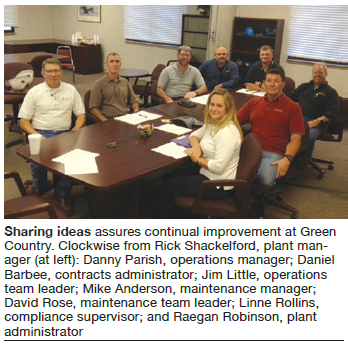Green Country Energy
Owned by J-Power USA
Operated by NAES Corp
800-MW, three gas-fired 1 × 1 combined cycles located in Jenks, Okla
Plant manager: Rick Shackelford
 From baseload to black plant: It’s a wild trip!
From baseload to black plant: It’s a wild trip!
Challenge.Other than significant natural disasters such as floods, tornados, and hurricanes, one of the potentially most damaging events a powerplant can experience is a black-plant trip. When such a trip occurs, all protective controls must function perfectly, all backup and emergency equipment must start up and operate as intended, and all O&M personnel must perform exceptionally—or significant equipment damage will likely occur.
Most powerplants have good black-plant procedures, and some even conduct routine black-plant drills. But it’s doubtful that most facilities plan adequately for an extended black-plant event in which back-feed power cannot be re-established for many hours.
The event: It was a beautiful January day with sunshine, mild temperatures, and all three of the plants 1 × 1 F-class combined-cycle units operating smoothly at baseload. The employees at Green Country had gathered in the control room after lunch for the plant’s weekly safety meeting. And then it happened.
The six generator breakers opened, the control room’s lights went out, the steam-turbine (ST) dump valves opened, the HRSG relief valves began to lift, and the fire alarms began sounding. The control-board operator announced, “We’ve lost everything, including the dedicated transmission line into the plant!”
Maintenance technicians moved quickly to inspect the operating condition of all emergency diesel-driven equipment and DC turbine/generator (T/G) emergency lubrication systems. The operations technicians manned the controls to monitor the proper startup of emergency backup equipment as well as the critical readings associated with the six turbines and generators that were coasting down from 3600 rpm.
The cause: One of the transmission-line protective relays had failed, causing the line breaker to open. To make matters worse, the plant experienced a subsequent lockout-switch failure in the switchyard, resulting in an eight-hour delay before electrical back-feed could be re-established to the plant.
Fortunately, Green Country is connected to a highly reliable transmission system, so black-plant events have been very rare over the 15 years since COD. However, in this case, the task of securing and protecting critical equipment following the trip was hampered by the eight-hour back-feed delay.
The successes: During the event, all critical emergency backup systems worked as designed, and plant technicians made good decisions. As a result, there was no damage to any plant equipment, or any unpermitted environmental releases.
The complications: Because power was lost to the plant’s auxiliary cooling-water and service-water pumps, heat exchangers, including the T/G lube-oil coolers, received no cooling water. Technicians connected firehoses to the auxiliary cooling-water header to pressurize it with potable water. They also started up the portable diesel-driven compressor to supply the plant’s main air header, thereby providing control air to most of the plant’s pneumatic equipment.
Power was lost to the ST hotwell dump valves as well as to unit sump pumps and various auxiliary systems critical to securing and cooling major equipment. To make things more interesting, darkness was setting in by 6 p.m., and the plant’s emergency lighting systems were losing their charge.
Portable radios also were also losing their power, making it difficult for our technicians in the field to communicate with the control room. Plus, the computer server went down, so we couldn’t send emails or access the plant’s shared files.
Solution. Numerous lessons were learned from this event, but the following stand out in importance:
- The exhaustive black-plant procedure previously developed by plant staff provided little value to the technicians who responded to the sudden challenge. A concise, readily available “Black Plant Quick Reference Guide” (Sidebar 1) would have been more useful to ensure that priority concerns were properly monitored and addressed.
- Technicians didn’t have adequate time to search the plant for portable emergency equipment. Again, a quick reference guide that listed all such assets and their locations would have been invaluable (Sidebar 2).
- An effective black-plant action plan should allow for an extended back-feed loss; and for such an event happening during an evening, night, or weekend (with only three employees on duty) or during worst-case circumstances such as maximum-capacity operation or adverse weather.
- Plant technicians did not have time to make multiple calls requesting assistance from offsite personnel. It would have helped to have a single-call procedure in place that designated an individual who would receive one call (the operations or plant manager) and would then make additional calls to obtain support.
- The plant should have been equipped with sufficient portable gasoline- or propane-powered equipment (water pumps, light plants, generators, etc) to meet the demands of an extended black-plant event (photos).

Results.We are now much better equipped to respond to a black-plant event—even an extended one. Plant leadership has refined processes and procedures, communicated expectations more clearly, and established and documented priorities.
 Project participants:
Project participants:
Rick Shackelford, plant manager
Danny Parish, operations manager
Michael Anderson, maintenance manager
Daniel Barbee, contracts administrator
Linne Rollins, compliance supervisor
Team leaders: Derek Hale, Dave Rose, Ewing Jackson, John Noftsger, Jim Little



